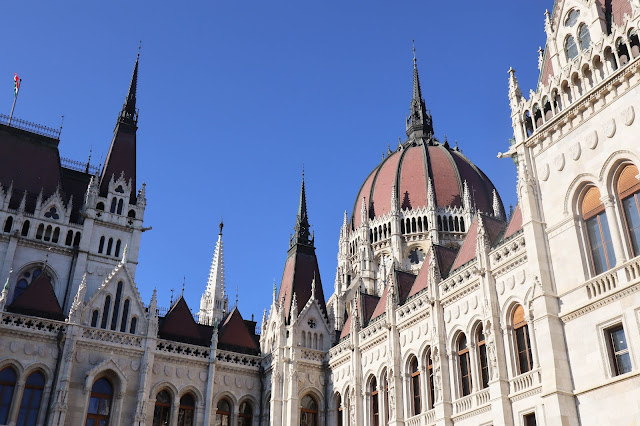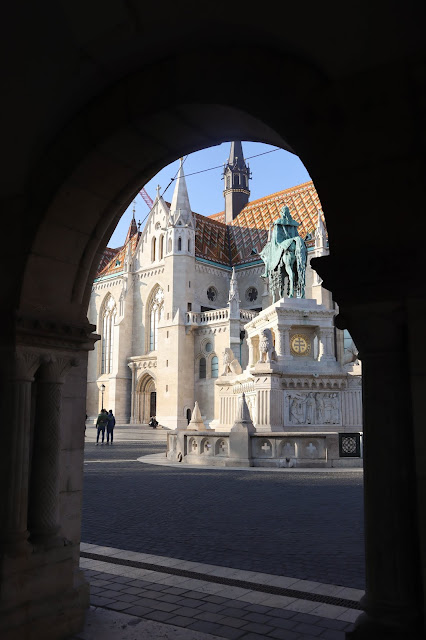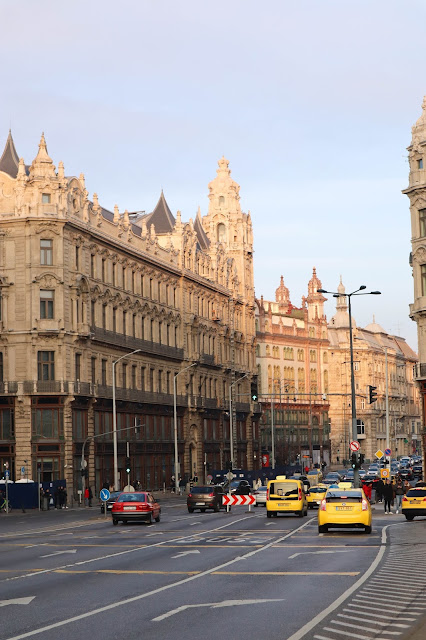
Budapest, Hungary’s capital, is bisected by the River Danube. Its 19th-century Chain Bridge connects the hilly Buda district with flat Pest. A beautiful and charming city that has everything for everyone. From cultural attractions to vibrant nightlife. Architecturally, the city is a treasure trove, with enough baroque, neoclassical, Eclectic and art nouveau buildings to satisfy everyone. The banks of the Danube are listed as a Unesco World Heritage site so it’s a joy to take a stroll along the Danube (especially at night when everything is lit up).
Budapest is a perfect weekend getaway or a perfect trip to make on your Central/Easter Europe vacation. It is not only very affordable place to travel to, but also safe. Often very popular by solo travellers or bagbackers.



WHAT TO DO & SEE?
1. Hungarian Parliament
The Hungarian Parliament Building, also known as the Parliament of Budapest after its location, is the seat of the National Assembly of Hungary, a notable landmark of Hungary, and a popular tourist destination in Budapest. This iconic building is the largest building in Hungary and it’s the third largest parliament in the world. Beautiful to admire around the building, from the Danube cruise oas well as across the river. Admire it from every angle!




2. St Stephen's Basilica
St. Stephen's Basilica is a Roman Catholic basilica in Budapest builtd in neoclassical style, Hungary. It is named in honour of Stephen, the first King of Hungary, whose right hand is housed in the reliquary.


3. Vajdahunyad Castle & City Park
Vajdahunyad Castle is one of the romantic castles in Budapest, located in City Park. It is a copy of Hunyad Castle, known as Corvin Castle, in Hunedoara, Romania. It was built in 1896 as part of the Millennial Exhibition which celebrated the 1,000 years of Hungary since the Hungarian Conquest of the Carpathian Basin in 895.
The castle was designed by Ignác Alpár to feature copies of several landmark buildings from different parts of the Kingdom of Hungary, especially the Hunyad Castle in Transylvania (now in Romania). As the castle contains parts of buildings from various time periods, it displays different architectural styles: Romanesque, Gothic, Renaissance, and Baroque. Originally, it was made from cardboard and wood, but it became so popular that it was rebuilt from stone and brick between 1904 and 1908. Today, it houses the Museum of Hungarian Agriculture, the biggest agricultural museum in Europe.
4. Hosok tere / Heroe's square
The largest square in Hungary and it celebrates the thousandth anniversary of Hungary. It also marks the entrance of City Park so you’re sure to come across this monument. Hősök tere or so called Heroes' Square, is one of the major squares in Budapest, Hungary, noted for its iconic Millennium Monument with statues featuring the Seven chieftains of the Magyars and other important Hungarian national leaders, as well as the Memorial Stone of Heroes, often erroneously referred as the Tomb of the Unknown Soldier. Nearby square you can also find the Museum of Fine Arts and the Palace of Art (Műcsarnok).
5. Szechenyi Thermal Bath
Budapest is blessed with an abundance of hot springs. As a result, ‘taking the waters’ has been an experience here since the time of the Romans. The array of bathhouses is generous – you can choose from Turkish-era, art nouveau and modern establishments.
Széchenyi, built in 1913, is probably the most popular and it’s a beautiful neo-baroque bath complex that consists of 11 medicinal pools and eight swimming pools. It’s also one of the largest spas complex in Europe.
6. Chain bridge
The Széchenyi Chain Bridge is a chain bridge that spans the River Danube between Buda and Pest, the western and eastern sides of Budapest, the capital of Hungary. At the time of its construction, it was regarded as one of the modern world's engineering wonders. It has asserted an enormous significance in the country's economic, social and cultural life, much as the Brooklyn Bridge has in New York and the US.

7. Liberty Statue & Citadella
The Statue of Liberty or Freedom Statue is located on the tip of the Citadella fortress on the Gellért Hill in Budapest. It commemorates those who sacrificed their lives for the independence, freedom, and prosperity of Hungary.

8. Gallert Thermal Bath
Gellért is another popular option to go for baths in Budapest. Part of the famous Hotel Gellért in Buda, the Gellért Thermal Baths and Swimming Pool, also known simply as the Gellért Baths, is a bath complex in Budapest in Hungary, known for Art-Nouveau style. Built in 1918, this opulent thermal bath complex features four thermal-medicinal pools, six other indoor pools, and two outdoor pools.
9. Buda Castle
Explore the historic castle district of the Hungarian capital and get to know the real Budapest! Visit the Buda Castle and other attractions in the castle and castle hill area. A perfect hilly area for amazing views over the river. Buda Castle is the historical castle and palace complex of the Hungarian kings in Budapest. It was first completed in 1265, but the massive Baroque palace today occupying most of the site was built between 1749 and 1769.






10. Fisherman's Bastion & Castle Hill
Perched above the city, Castle Hill is a must-visit neighborhood of Budapest. Some of the buildings date back to 14th and 15th centuries. Set aside a day to discover its winding cobble stone streets. The area also contains many of Budapest’s top attractions like Trinity Square, Matthias Church (Mátyás templom), Fishermen’s Bastion (Halászbástya), and Buda Castle.
The Halászbástya or Fisherman's Bastion is one of the best known monuments in Budapest, located near the Buda Castle. It is one of the most important tourist attractions due to the unique panorama of Budapest from the Neo-Romanesque lookout terraces. The building was formerly known as the 'Fishermen's Bastion', presumably from the section of the Buda City Wall entrusted to the guild of fishermen, but more likely to the Danube side settlement, Fishtown (Halászváros) also called Watertown.







11. Great Synagogue
The Dohány Street Synagogue, also known as the Great Synagogue, is a historical building in Erzsébetváros, the 7th district of Budapest, Hungary. It is the largest synagogue in Europe seating 3,000 people and is a centre of Neolog Judaism.
The synagogue was built between 1854 and 1859 in the Moorish Revival style, with the decoration based chiefly on Islamic models from North Africa and medieval Spain (the Alhambra). The Dohány Street Synagogue complex consists of the Great Synagogue, the Heroes' Temple, the graveyard, the Memorial and the Jewish Museum, which was built on the site on which Theodor Herzl's house of birth stood.
WHERE TO GO EAT & DRINK?
Budapest is an international city. Therefore you will find different cuisine and many food choises around here. However, if you are looking for something more tradition, try these dishes:
- Főzelék is such a unique Hungarian dish it can’t be translated into English. Though it looks like a soup at first sight, a more accurate description might be a thick vegetable stew.
- A special sweet spiral cylindered bread made from sweet yeast dough baked over charcoal and coated in plenty of sugar. This is the secret of kürtös kalács, one of Hungary’s most beloved street pastries.
- Langos - A plate-sized sheet of fried dough that is usually smothered with sour cream and cheese. Other possible toppings include garlic sauce or ketchup.
- Goulash, this popular soup is a Hungarian original. It contains chunks of beef, potatoes, and vegetables, plus plenty of paprika and spices.
- Töltött Káposzta (stuffed cabbage) - Large leaves of cabbage, stuffed with meat and rice, which are cooked and then smothered with sour cream.
New York Cafe Budapest opened its on doors at the end of the 19th century. The luxurious decor of the New York Café in Budapest, with its colourful paintings on the ceiling, its golden details and the marble pillars, is overwhelming. New York Cafe Budapest holds the title for being the world's most beautiful cafe. No wonder that the queues are long and people are trying to get in to admire the beautiful interior of this cafe whcih is part of a hote now. Perfect spot to go for a coffee break.
Mazel Tov is a lovely ruin bar and hip restaurant in the old Jewish District in Budapest offering a warm, buzzing atmosphere, and delicious Middle Eastern cuisine.
Langos is one of the popular street food dish of Hungary. You'll find it pretty much on every stall, especially at Christmas markets. If youa re outside of Christmas season, do not worry, you'll stulll find plenty of quick takeway & sit in dining places to taste this!
Arán, which means "bread" in Old Irish, is a pricey craft bakery in Budapest's hip Jewish Quarter. Perfect industrial looking bakery is a great stop to grab your morning coffee & fresh bakery.


Karaván, located next to Szimpla, is yet another reason to explore Budapest's busy party street, Kazinczy utca. It's technically an outdoor open space food court. You wil definitely find some traditional hungarian dishes, like langos or goulash in here too.


Szimpla Kert is one of the best bustling ruin bars in Budapest, and the oldest of them all, with a vibrant atmosphere, eclectic crowds on most nights. They serve food, drinks and music every day.

Twentysix Budapest is the first of its kind, a cozy urban jungle and feel-good hub for all the nature and gastro friends, located inside a building surrounded by community led businesses, such as co-working space or yoga studio. A great place for a meal out or just drinks.
Chic rooftop bar with 360 degree city views. Perfect to end your day here with cocktails and small bites. The rooftop ave both indoor and outdoor spaces, so it is suitable for any time of the year!
If you are looking for a delicious place for your breakfast, brunch or even lunch, try Szimply for theri colourful and healthy dishes.
Located just in the city center around the corner of chain bridge, Szazeves Etterem restaurant offers visitors traditional Hungarian dishes in a cozy atmosphere. If you are lucky, they often have live music bands in here too!















































1 Comments
This is a very charming city, i hope i can return to visit sometimes in the future when all this is over. seeing and sharing place like this is why i love traveling and make blog so much!
ReplyDelete